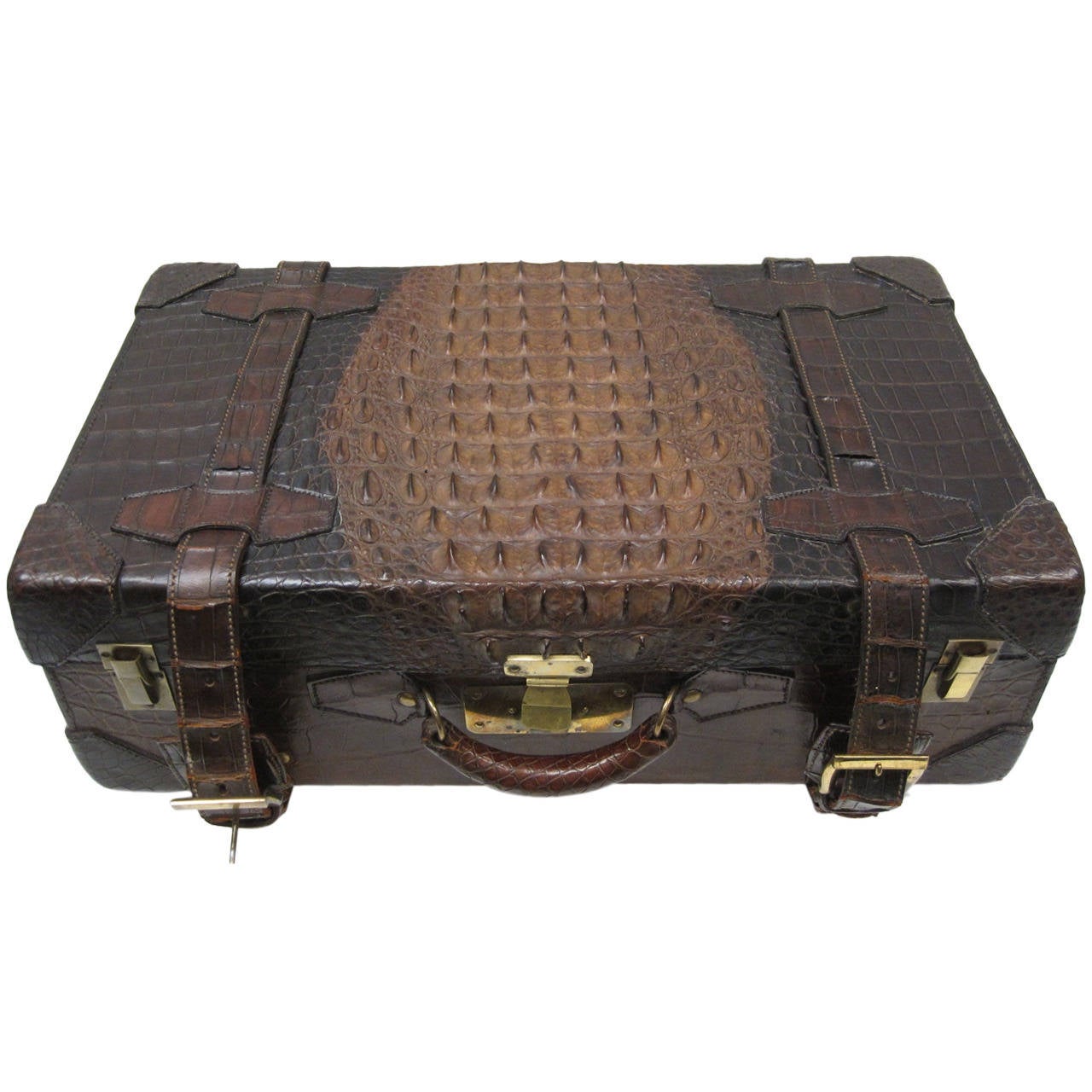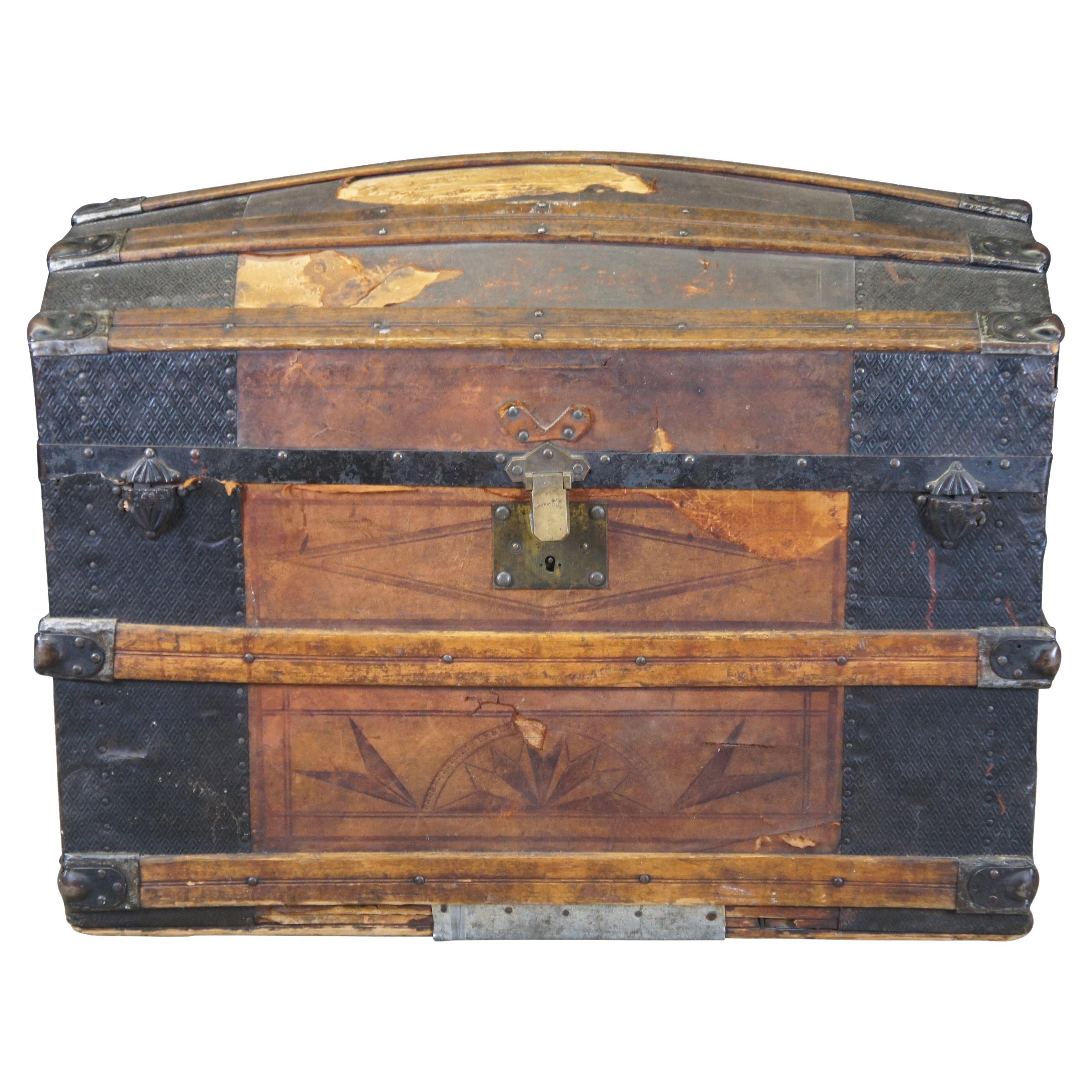Items Similar to Antique 19th Century Victorian Leather Suitcase With Painted Crest c.1850
Want more images or videos?
Request additional images or videos from the seller
1 of 21
Antique 19th Century Victorian Leather Suitcase With Painted Crest c.1850
About the Item
Antique mid-19th Century Victorian leather suitcase with a painted family crest. The suitcase is very well kept and features the original cotton lining, document holder and dust covers with leather straps. Throughout, brass hardware such as the lock plate, buckles and rivets feature throughout. At a later date, a familial crest has been painted on the outside in an array of bright colours depicting royal lions, flags and a castle crest. This case exemplified a merging of style and practicality, embodying the spirit of a transformative era in travel.
CONDITION
In Good Condition - Some light wear consistent with normal use, please refer to photographs.
SIZE
Height: 20 cm // 7.87 in
Width: 61 cm // 24.02 in
Depth: 36 cm // 14.17 in
- Dimensions:Height: 7.88 in (20 cm)Width: 24.02 in (61 cm)Depth: 14.18 in (36 cm)
- Style:Victorian (Of the Period)
- Materials and Techniques:
- Place of Origin:
- Period:
- Date of Manufacture:1850
- Condition:Wear consistent with age and use. In Good Condition - Some light wear consistent with normal use, please refer to photographs.
- Seller Location:Royal Tunbridge Wells, GB
- Reference Number:
About the Seller
5.0
Platinum Seller
These expertly vetted sellers are 1stDibs' most experienced sellers and are rated highest by our customers.
Established in 2014
1stDibs seller since 2015
379 sales on 1stDibs
Typical response time: <1 hour
- ShippingRetrieving quote...Ships From: Sherring, United Kingdom
- Return PolicyA return for this item may be initiated within 14 days of delivery.
More From This SellerView All
- 20th Century Revelation Expanding Leather Suitcase, c.1920Located in Royal Tunbridge Wells, KentAntique early 20th Century Bridle Hide Revelation expanding leather suitcase, a hallmark of innovation from the 1920's, showcased a pioneering design that allowed for adjustable stor...Category
20th Century British Trunks and Luggage
MaterialsBrass
- 19th Century Victorian Dressing Case By W Insall & Sons, c.1890Located in Royal Tunbridge Wells, KentAn antique 19th Century victorian dressing case in English bridle leather by W Insall of Birmingham. This piece is lined in green baize with or...Category
Antique 19th Century British Victorian Trunks and Luggage
MaterialsLeather
- 20th Century British Made Bridle Leather Suitcase, c.1910Located in Royal Tunbridge Wells, KentAntique early 20th Century British made Bridle hide covered suitcase. The leather shows wear but is still supple, mounted with brass fittings, oozing charm and elegance. A truly grea...Category
20th Century British Trunks and Luggage
MaterialsLeather
- 20th Century British Made Bridle Leather Suitcase, c.1910Located in Royal Tunbridge Wells, KentAntique early 20th Century British made Bridle hide covered suitcase. The leather shows wear but is still supple, mounted with brass fittings, oozing charm and elegance. A truly grea...Category
20th Century British Trunks and Luggage
MaterialsLeather
- 19th Century Victorian Teak & Mahogany Seamans Trunk, circa 1890Located in Royal Tunbridge Wells, KentAntique late-19th century Teak and mahogany domed top ship's trunk, inscribed with initials, with brass strapped corners and fittings, stop handles of steel, with pair of original wo...Category
Antique 19th Century English Trunks and Luggage
MaterialsTeak
- 20th Century Louis Vuitton Cow Hide Suitcase, France c.1920By Louis VuittonLocated in Royal Tunbridge Wells, KentA highly unusual and exceptionally rare Louis Vuitton suitcase, originating from the early years of the 20th century, distinguishes itself not with the globally renowned monogram canvas but with a distinctive covering crafted from a singular piece of cowhide. This unique piece represents a special order from Louis Vuitton, showcasing the brand's historical commitment to utilizing only the finest hides available. Unlike many of its counterparts, leather trunks and cases of this era often struggle to withstand the test of time, requiring regular treatments to prevent drying and disintegration. Remarkably, this particular example defies the odds, retaining the same supple quality it possessed on the day it first graced the shop floor. This suitcase belongs to Louis Vuitton's collection of "speciality materials," which encompasses a diverse range, including, but not limited to, zinc, copper, crocodile leather, and cow leather. A brief history about Louis Vuitton trunks: Louis Vuitton was born in 1821 to a farmer and milliner and came from a long-established working-class family in eastern France. Vuitton grew up understanding the effects of perseverance and a strong work ethic from watching his family. At the age of 16, he made the decision to walk 292 miles from his hometown to Paris to try and make a new life for himself. When he arrived the city was in the midst of industrialization with current modes of transportation evolving quickly allowing for longer journeys. With this came the need for sturdy travel pieces. Vuitton was taken as an apprentice for a successful box maker and packer named Monsieur Marechal. He learned to craft durable containers and how to pack them properly – a well-respected profession at the time.In 1854, years after he had mastered his craft and became well respected for it, Vuitton ventured out on his own to open a shop on Rue Neuve des Capucines. It was here that he began to establish himself as a luggage maker. Then, in 1858, Vuitton designed the first Louis Vuitton steamer trunk. At the time trunks had rounded tops to allow for water to run off but this did not allow for convenient stowage. Vuitton introduced a flat, yet waterproof, trunk that was easily stackable. The first of his trunks were outfitted with a grey canvas referred to as Trianon – it wouldn’t be until several decades later that the signature monogram would be introduced. With a burgeoning business, Vuitton moved his family and workplace to Asniere, where he employed twenty workers to craft his trunks. By 1900 he would have 100 employees, and in 1914 the company would more than double in size. After years of success, Vuitton began to experiment with the design of his luggage by introducing a new striped canvas pattern (1876) and later the still well-known Damier print (1888). The hand-painted patterns were developed to prevent counterfeits. Even in the late 1800s, Louis Vuitton was enough of a status symbol to warrant counterfeiting. In 1886, his son George invented and patented an ingenious locking system that made it impossible to pick the lock of their trunks. This lock is still used today. 1892 would prove to be a time of mourning for the family as Louis Vuitton passed...Category
20th Century French Other Trunks and Luggage
MaterialsBrass
You May Also Like
- 19th C. Victorian Original Double Handled Initialed Leather Portmanteau SuitcaseLocated in Vancouver, British ColumbiaRare large leather double handled Victorian portmanteau. Beautifully handcrafted with attention to detail. In original unrestored condition. Initial plaque may be screwed in from wit...Category
Antique 1860s English Victorian Trunks and Luggage
MaterialsBrass
- 19th Century Peruvian Stitched Leather SuitcaseLocated in Marbella, ES19th Century Peruvian leather suitcase with decorative stitching.Category
Antique Mid-19th Century Peruvian Trunks and Luggage
MaterialsLeather
- 19th Century Alligator SuitcaseLocated in Hamilton, OntarioAmerican made suitcase manufactured by Hulbert Bros. They were in business from 1870-1909 in Salt Lake City, Utah. Free shipping within the United Stat...Category
Antique Late 19th Century Trunks and Luggage
MaterialsAnimal Skin
- Spanish Painted Leather Trunk, 19th CenturyLocated in Los Angeles, CA19th century Leather hand painted trunk. The paint detailing is beautifully done with rows of antique nailheads detailed throughout the trunk.Category
Antique 19th Century Spanish Spanish Colonial Trunks and Luggage
MaterialsLeather
- Antique 19th Century Victorian Tooled Leather & Oak Dome Top Steamer Trunk ChestLocated in Dayton, OH"A large and impressive Victorian era dome top steamer trunk, circa 1870s. Features a tooled leather and oak frame with geometric diamond patter...Category
Antique 1870s Victorian Trunks and Luggage
MaterialsMetal
- 19th Century Victorian Decoupage ScreenLocated in New York, NYEnglish late Victorian painted and decoupage 4-panel screen with figurative scenes on both sides of screen.Category
Antique Late 19th Century Late Victorian Screens and Room Dividers
MaterialsPaper, Wood
Recently Viewed
View AllMore Ways To Browse
1850 Victorian
Victorian Leather
Family Crests
Antique Family Crest
Leather Document
Antique Photograph Plates
Lion Crest
Antique Family Photographs
Crest Royal
Antique Leather Straps
Late 19th Century Brass Hardware
Royal Flag
Antique Travel Trunks Luggage Trunks
Victorian Hardware
Victorian Buckle
Antique Leather Travel Case
Leather Document Case
Antique Suitcase





